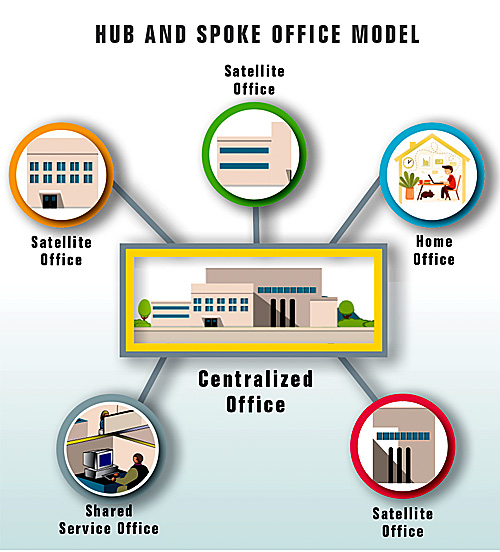The “Hub and Spoke” Model
As population shifts away from major “hub” markets, businesses and real estate developers are reimagining how to help people work. A hub and spoke model of centralized offices (hubs) downtown and satellite offices (spokes) in the surrounding areas is not a new concept. What’s changed is the demand for “spoke” offices and the definition of what a “spoke” can be.
“Spokes” of the Future
The availability of affordable technology for every person to own and use within their home has made high-level, productive remote work possible. As remote workers now enjoy a similar degree of “business infrastructure” historically only available at company offices, an opportunity to innovate where and how we work has arrived.
The New Hybrid Work Model
A dispersed workforce and the resulting demand for agility has created an immediate need for businesses to rethink how they support their workers. Working from home or the office is no longer a binary decision. Now, remote work can mean from home, a shared service office (spoke), a company provided satellite office (spoke), or a combination of the like.
Businesses and employees are both reaping the rewards of a more agile, dispersed workforce and workplace. Shared Benefits
Businesses and employees are both reaping the rewards of a more agile, dispersed workforce and workplace. Individuals have enjoyed significant work/life balance improvements. Commute times have decreased on average by one and a half hours a day, which means significant cost savings on transportation, food, maintenance, and other related expenses. More importantly, as stated, the ability for people to choose where and how they work has provided a better work/life balance.
Businesses that have embraced agility are realizing the benefits as well. Reduced real estate cost, improved staff retention/attraction, and additional flexibility allow for a more sustainable business model. Let’s not overlook the importance of staff retention and attraction. Cost of real estate is nothing compared to the cost of high turnover or the need to outsource recruiters and staffing agencies to fill jobs.
Nontraditional Workspaces and the Service Office Boom
Smart companies are those that are open and able to adapt as markets and times change. One trend that early adopters of the hybrid hub and spoke model are moving toward is the use of defunct shopping centers. The trend of re-adapting shopping malls and strip centers as offices is driven by developers because people exist in those areas who can support the economic needs of the business, including having the demographics surrounding these areas to provide workers.
Repurposing desolate shopping centers as shared service offices and “last mile” fulfillment centers allows businesses to go where people already live, utilize existing real estate in a tight market, and better position themselves in a dynamic and difficult supply chain logistics environment.
Feasibility
Not all markets are suitable for hub and spoke models. Hickey and Associates, in conjunction with Instant Group, has developed a propensity model to determine which mega cities around the world are most hospitable for satellite offices. The following attributes were found to be the main determinants:
- Commute time – 30%
- Share of population age 35+ – 20%
- Median household income – 20%
- Total employment by selected occupation – 15%
- Concentration of employment by selected occupation – 15%
Top 5 Priorities According to Corporate Real Estate Executives
As workforce trends change, so do real estate portfolios. Prioritizing location strategy that can meet labor demands now, and in the future, has led corporate real estate executives to focus on the following: Physically tedious positions have already or will soon be replaced with AI-enabled robotics.
- Align CRE outcomes with corporate strategy — Increase agility, decrease cost, increase employee engagement and productivity.
- Understand your demographics — What demographics and roles already exist within your workforce?
- Review the geographical footprint of your workforce — How might this change in the future?
- Map out the function locations your current portfolio supports — Where do the gaps exist?
- Build out your future portfolio — Focus on your people and the business needs.
Contrary to popular belief, enhanced unemployment is not the main reason businesses are finding it difficult to fill low-level positions. Many people used quarantine to their advantage by training for better jobs and taking the “leap” into new professions that time and money constraints would have made riskier in the past.
Automation is the future, and the future is here. Physically tedious positions such as warehouse sorters, grocery packers for delivery, and even flipping French fries at a fast-food restaurant have already or will soon be replaced with AI-enabled robotics. Companies need workers that have skills for the future, now. Developing an agile, upskilled workforce for the jobs of today and “tomorrow” is the next great challenge for businesses.
Moving Forward
As of now, businesses are still working to navigate the future of their workplace coming out of the pandemic. Some expect workers back to the city center office. Some have fully embraced work-from-home and remote work. Some are offering a truly hybrid option of all the above.
No one knows just yet how to perfectly adapt with our new normal of agile, dispersed labor markets. What we do know is embracing what works, where it works, and how it works can be supported with detailed data, indexing, and analytics. By leveraging strategic tools and innovative thinking, smart companies will discover the optimal solutions that are the best fit for the business, along with its workforce.



